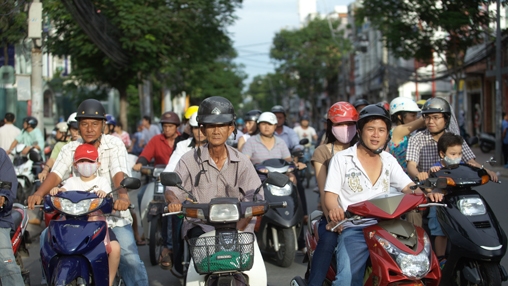April 5, 2012 - Travelling to and from work for Thuy Phuong Nguyen is a daily struggle for the 28-year old office worker in Hanoi. Zigzagging through the busy streets on her motorbike, the 40-minute ride leaves Thuy’s energy drained.
“The traffic, the honking and the smog makes my trip very tiring,” Thuy laments. She adds that “the city’s population is increasing so fast, but the infrastructure has not improved.”
Thuy notices that more and more cars are plying the streets of Hanoi, and she fears the roads will be even get more clogged in the near future. Buying a car for herself is out of the question, “since it would take forever to get to work and parking is more difficult to find in the city center.”
The World Bank’s Vietnam Urbanization Review confirms that Hanoi’s roads, like Ho Chi Minh City, are indeed not ready for more motor cars. The Review, which takes a look at the country’s urban transition, reveals that Vietnamese cities still enjoy relatively good urban mobility. However, with car ownership on the rise, this may eventually lead to gridlock given the very low road to population density ratio of the country’s two largest cities. A car takes up more than four times the road space of a motorbike.
The Urbanization Review indicates that the country is at an early stage of urbanization that’s quickly moving forward. It places the country’s annual urban population growth at 3.4 %, with growth the fastest in and around the country’s largest cities of Hanoi and Ho Chi Minh City.
These two cities primarily drive the country’s rapid economic growth, with industries concentrated here and their surrounding areas. Ho Chi Minh and the Southeast region are host to nearly half of overall manufacturing production while higher value manufacturing is increasing more rapidly in Hanoi and the Red River Delta region.
Great benefits come with urbanization and no country has reached high income status without first urbanizing and nearly all countries are at least 50% urbanized before reaching middle-income. The 1986 Doi Moi reforms unleashed Vietnam’s economic transformation, with urbanization reinforcing strong economic growth. The growth of its cities has increased prosperity in Vietnam in the span of less than 30 years, but its citizens have to deal with some significant growing pains of rapid urbanization such as increasingly poor air quality, traffic congestion, and property values rising out of the reach of most citizens.
Taking the bus is also not an option for Thuy because she finds them to be very overcrowded, and with the nearest stop “very far from my home.” Just like most city-dwellers, her preference for using her own bike will ‘run counter to plans for public transport systems’ according to the review.
The World Bank suggests that motor bikes have been a short term solution to urban dwellers’ transport needs. However, the Review also indicates that plans for public transport should get ahead of the shift from motorbikes to cars. In the bigger picture, the review also calls for the integration of land use planning and development with transit and urban transport development.
Thuy has considered moving closer to the city center but was also discouraged like most Vietnamese. Findings from the Review show that overall, the government has done well in providing its citizens with basic services and the lack of large-scale slums suggests housing needs are largely being met. But increasingly it is becoming harder for new households to access housing and the Review suggests that only about 5% of the population is able to afford homes currently being produced by large developers in the two largest cities.
“Addressing affordable housing needs is becoming a growing priority for local governments,” assures Dean Cira, Lead Urban Specialist of the World Bank.
Thuy has seen the rise of residential buildings in the city in recent years but notes she couldn’t afford to buy any property. “It would take me some 60 years to buy an average apartment in the city,” estimates Thuy given her current income, and the high price of properties in Hanoi.
With such a situation facing a majority of urban residents, monitoring land and housing markets is seen by the World Bank as crucial in ‘helping urban economies to function efficiently and equitably.’
Given the various challenges in the country’s changing urban environment, the Review recommends a more effective approach to planning and development that more accurately responds to the needs of the market. It also calls for closer integration and coordination of the planning system among various stakeholders.
“I really hope the city planners can find a way to make housing more accessible to people with average income like me," Thuy airs, as she, along with Vietnam’s 26 million urban dwellers seek to reap the benefits of Vietnam’s urban transformation.

